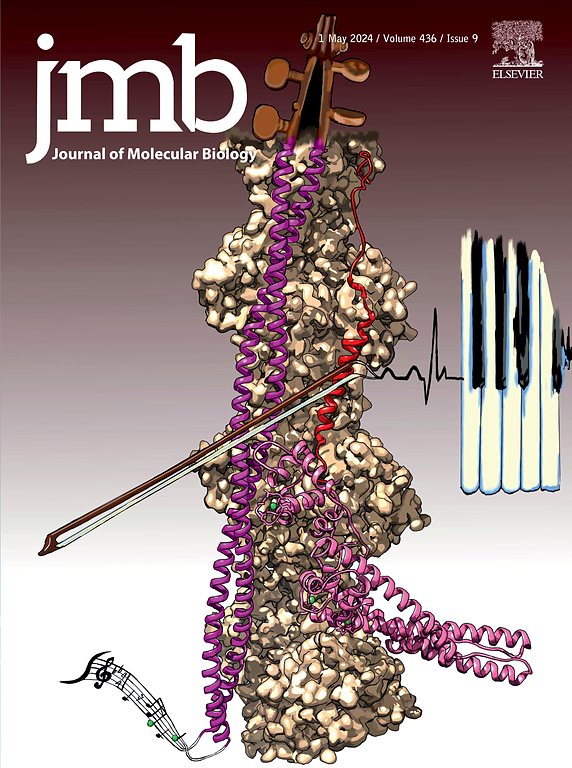使用语言模型的几何深度学习识别rna -小分子结合位点。
IF 4.7
2区 生物学
Q1 BIOCHEMISTRY & MOLECULAR BIOLOGY
引用次数: 0
摘要
rna正在成为有希望的治疗靶点,然而识别与它们结合的小分子仍然是药物发现中的一个重大挑战。这强调了计算建模在预测rna -小分子结合位点中的关键作用。然而,目前仍然缺乏准确有效的计算方法来识别这些相互作用。最近,先前在DNA和蛋白质研究中取得成功的大型语言模型(llm)的进展刺激了rna特异性llm的发展。这些模型利用大量未标记的RNA序列来自主学习语义表示,以增强下游任务,特别是那些受有限注释数据约束的任务。在这里,我们开发了RNABind,这是一个嵌入信息的几何深度学习框架,用于从RNA结构中检测RNA-小分子结合位点。RNABind将RNA llm集成到高级几何深度学习网络中,该网络编码RNA序列和结构信息。为了评估RNABind,我们首先从整个多链复合物结构而不是单链rna中编译了最大的rna -小分子相互作用数据集。大量的实验表明,RNABind优于现有的最先进的方法。此外,我们对8个预训练的RNA llm进行了广泛的实验评估,在统一的实验方案下评估它们在结合位点预测任务中的表现。综上所述,RNABind为探索rna -小分子结合位点预测提供了一个强大的工具,为未来rna靶向药物发现的创新铺平了道路。本文章由计算机程序翻译,如有差异,请以英文原文为准。

Identifying RNA-small Molecule Binding Sites Using Geometric Deep Learning with Language Models
RNAs are emerging as promising therapeutic targets, yet identifying small molecules that bind to them remains a significant challenge in drug discovery. This underscores the crucial role of computational modeling in predicting RNA-small molecule binding sites. However, accurate and efficient computational methods for identifying these interactions are still lacking. Recently, advances in large language models (LLMs), previously successful in DNA and protein research, have spurred the development of RNA-specific LLMs. These models leverage vast unlabeled RNA sequences to autonomously learn semantic representations with the goal of enhancing downstream tasks, particularly those constrained by limited annotated data. Here, we develop RNABind, an embedding-informed geometric deep learning framework to detect RNA-small molecule binding sites from RNA structures. RNABind integrates RNA LLMs into advanced geometric deep learning networks, which encodes both RNA sequence and structure information. To evaluate RNABind, we first compile the largest RNA-small molecule interaction dataset from the entire multi-chain complex structure instead of single-chain RNAs. Extensive experiments demonstrate that RNABind outperforms existing state-of-the-art methods. Besides, we conduct an extensive experimental evaluation of eight pre-trained RNA LLMs, assessing their performance on the binding site prediction task within a unified experimental protocol. In summary, RNABind provides a powerful tool on exploring RNA-small molecule binding site prediction, which paves the way for future innovations in the RNA-targeted drug discovery.
求助全文
通过发布文献求助,成功后即可免费获取论文全文。
去求助
来源期刊

Journal of Molecular Biology
生物-生化与分子生物学
CiteScore
11.30
自引率
1.80%
发文量
412
审稿时长
28 days
期刊介绍:
Journal of Molecular Biology (JMB) provides high quality, comprehensive and broad coverage in all areas of molecular biology. The journal publishes original scientific research papers that provide mechanistic and functional insights and report a significant advance to the field. The journal encourages the submission of multidisciplinary studies that use complementary experimental and computational approaches to address challenging biological questions.
Research areas include but are not limited to: Biomolecular interactions, signaling networks, systems biology; Cell cycle, cell growth, cell differentiation; Cell death, autophagy; Cell signaling and regulation; Chemical biology; Computational biology, in combination with experimental studies; DNA replication, repair, and recombination; Development, regenerative biology, mechanistic and functional studies of stem cells; Epigenetics, chromatin structure and function; Gene expression; Membrane processes, cell surface proteins and cell-cell interactions; Methodological advances, both experimental and theoretical, including databases; Microbiology, virology, and interactions with the host or environment; Microbiota mechanistic and functional studies; Nuclear organization; Post-translational modifications, proteomics; Processing and function of biologically important macromolecules and complexes; Molecular basis of disease; RNA processing, structure and functions of non-coding RNAs, transcription; Sorting, spatiotemporal organization, trafficking; Structural biology; Synthetic biology; Translation, protein folding, chaperones, protein degradation and quality control.
 求助内容:
求助内容: 应助结果提醒方式:
应助结果提醒方式:


